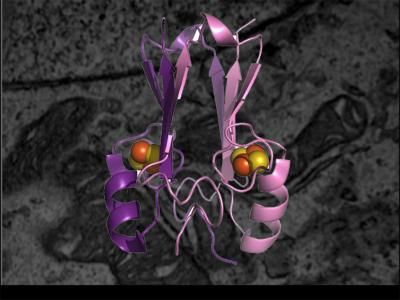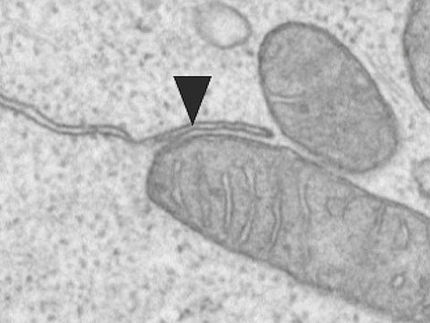NEETs are prime suspects in breast cancer proliferation
Proteins blocked in diabetes treatments connected to lower incidence of cancer in patients
Advertisement
Two proteins have been identified as prime suspects in the proliferation of breast cancer in a study by an international consortium of researchers from Rice University, the University of North Texas, Denton (UNT); the University of California, San Diego (UCSD); and the Hebrew University of Jerusalem.

P. Jennings/UCSD
The research, which appears this week in the Proceedings of the National Academy of Sciences' Online Early Edition, may offer a path to therapies that could slow or stop tumors from developing.
Rice's Center for Theoretical Biological Physics (CTBP) coordinated the research, which found that reducing the expression of a pair of proteins known as NEETs -- NAF-1 and mitoNEET -- significantly reduced cancer cell proliferation and breast cancer tumor size.
The research stemmed from a recent CTBP study of the shape and functions of one of the proteins, mitoNEET. The other protein, NAF-1, is closely related to mitoNEET.
CTBP co-director José Onuchic, a biological physicist at Rice, said the new study was triggered by the team's recognition of a connection between NEETs and reduced rates of breast cancer among women who take a diabetes drug that targets mitoNEET.
"NEET proteins play a key role in the overall stress response of cells," Onuchic said. "Anytime you stress a system, these proteins are there to help, but in cases where cells are overcome by stress, NEETs can become highly overexpressed. That's what drew our interest in a potential connection to cancer."
Onuchic, Rice's Harry C. and Olga K. Wiess Professor of Physics and Astronomy, co-authored the study with longtime research partner Patricia Jennings, professor of chemistry and biochemistry at UCSD; Rachel Nechushtai, a professor at the Alexander Siberman Life Science Institute of the Hebrew University of Jerusalem; and Ron Mittler, professor of biological sciences at UNT.
NEET proteins transport iron molecules or iron sulfur clusters inside cells. The proteins naturally adhere to the outer surface of the mitochondria, the "power plant" that supplies cells with chemical energy. Mitochondria also play a role in a cell's life cycle, including its death.
"Maintaining mitochondrial health is a key factor in the health of a cell," said Nechushtai. She and Mittler are experts in iron and reactive oxygen metabolism and collaborated on a prior study that identified a key role for NEET proteins in maintaining mitochondrial function in cells under conditions that resembled cancer cell metabolism.
"We found that novel motions in NEET proteins control cluster properties and suggest the NEET proteins can be your best friend or worst enemy," Jennings said.
"Based on our own prior results and the recent CTBP findings, we decided to examine the role that NEET proteins and iron metabolism might play in conferring drug resistance to breast cancer cells and tumors," Nechushtai said.
Experiments in Mittler's and Nechushtai's labs found an overabundance of both mitoNEET and NAF-1 in breast cancer cells. Moreover, the team found a direct correlation between NEET protein levels and the overall progression of the disease.
The results suggest that the overabundance of NEETs is a factor in the runaway growth of cancer cells, and that would make NEETs a prime target for anticancer drugs.
"Developing drugs that target important cellular pathways that are specific for cancer cells is perhaps the most important goal of anticancer therapy," Mittler said. "Historically, mitochondrial pathways have largely been overlooked, but our results indicate that these are important pathways and that targeting the NEET proteins could have a significant effect."
Jennings and Nechushtai first detailed the molecular structure of mitoNEET in 2007. They were also the first to analyze the unique structural features of NAF-1 three years ago. That work led to the realization that NAF-1 and mitoNEET had similar structures. But it also showed the two had distinct surface features, which means each interacts with a different set of partner proteins and can be individually targeted with drugs.
"What's interesting about these two proteins is that mitoNEET is always on the surface of the mitochondria membrane, while NAF-1 is on the mitochondria and the endoplasmic reticulum," Onuchic said. "A lot of messaging rolls between these two proteins. You have to affect both of them to stop proliferation."
Jennings said the researchers took the path less traveled in making their latest finding. "We work opposite from the way most people do," she said. "We start with the structure of a protein -- usually one with important properties but unknown function -- and we move into the biology from that point.
"In the case of the NEETs, we knew about the connection to diabetes, and Rachel and Ron's work showed the key regulation point involved iron and redox metabolism," Jennings said. "Ron's functional studies took us from the computational and cellular arena into the whole organism -- for example, in plants -- and confirmed that NEETs have an ancient role in iron and reactive oxygen metabolism."
Ideally, the researchers said, they would like to see drug designers create small molecules that are customized to target cancer cells and block NEETs from interacting with other proteins that are key players in chemotherapy drug resistance. There's also a chance that using this approach could make tumors more susceptible to standard chemotherapy.
"Your immune system is trained to build resistance to one attack, but not to a coordinated attack," Onuchic said.


























































